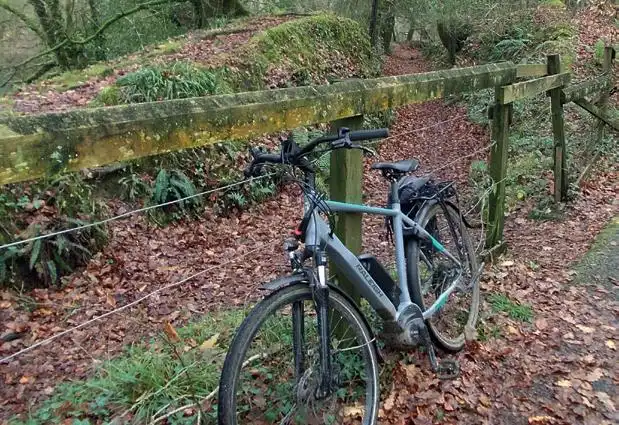
4 minute read
History
A mysterious aquaduct...

Advertisement
Ron Smith investigates some historic remains

The leat leaving the railway cycle path

How often have you cycled or walked between Plymbridge and Clearbrook up the old railway track? How often have you wondered at the old aqueduct bridging the trail by the downhill end of the old railway tunnel? I had always assumed that it was an old mine leat, and moreover that it connected with the obvious signs of a leat, level with the cycle track a short way along from the uphill end of the tunnel. See the two main pictures illustrating this article. I fi nally got around to scratching my itch for knowledge at the back end of 2020. It involved lots of rough walking through brambles along the actual line of the leat - it was fun! Also research with old large scale maps; and research to date the old railway and the actual mine. Yes, it had been a mine leat, to power a water wheel for Wheal Lopes. I will start at the beginning. A leat draws water from a river. As

the river tumbles downhill, the leat fl ows sedately along, almost contouring, with just a slight incline to keep the water fl owing. So where was the ‘head weir’? It turned out to be on the River Meavy, 50 metres downstream from Hoo Meavy Bridge, down the hill below the famous Skylark Inn in Clearbrook. I leant on the parapet as a man with a dog came by, and asked him if he knew anything about it. Of course he did! He owned the fi eld with the lovely horses in it, with a very slight depression across the fi eld indicating the line of the fi lled-in leat. He pointed out the remains of the weir in the river, largely washed away by many years of storms. I was then able to fi nd the leat itself, here in good condition still, at the foot of the steep wooded bank the other side of the fi elds by the river. I was able to follow this leat nearly all the way to the railway
tunnel. It was fascinating to fi nd how it had to use culverts to cut under the old railway and lanes to bypass above Goodameavy Bridge, and then variously culvert back to emerge level and parallel to the cycle track as mentioned earlier. I had already found these details on the old map. I strongly recommend that next time you pass, you look for these. They are obvious, once you know what you are looking for. So far so good; but the old map then presented a further mystery. Shortly further on, round the hillside by the side of the railway tunnel, it vanished completely, re-appearing shortly before it crossed on the aqueduct. More enjoyable scrambling was needed, around a bouldery hillside. This mystery too was solved - our leat had its own private tunnel. The entry was blocked by earth slide, but the exit was delightfully clear and photogenic. I could now reach the aqueduct from above. The leat continued in the steep wood beyond the aqueduct, disappeared in a fi eld, culverted under a lane, proceeded through the next wood and fi nally disappeared in substantial fi elds. At this point it was no longer parallel to the cycle track, but heading up the valley towards Wheal Lopes, marked on the old map as crossing several

Main image: The aquaduct passing above the old railway tunnel Inset top: The leat emerging from its tunnel Inset bottom: Take care exploring Wheal Lopes! farmer’s fi elds, but leaving no actual traces. The old map shows several disused shafts on either side of a stream and lane in private woods. My next step is to trace the leat in these woods, but not alone and not without permission. I did glance into them; see warning photo. The site is just over a km NNW of Bickleigh village, along Upperton Lane. It is shown on the modern 1:25 000 scale map (Ordnance Survey Explorer series) So what was Wheal Lopes? It was a classic, up and down copper mine, making a small profi t, then closing, auctioned with big advertising, typically losing money for its naïve city-based investors. When the railway line was being built from 1856, it was about to close for the last time; but was still active enough to require its leat to be retained in operational condition; hence the aqueduct. It is on the Maristow Estate, owned by the Lopes family. All the papers pertaining to it were transferred from the estate offi ce to the local record offi ce a very few years ago. They are now held in The Box; I look forward to consulting them for more details when The Box reopens. Watch this space perhaps. n

Ron Smith










